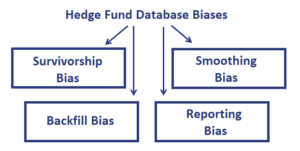Hedge Fund Database Biases
Hedge fund databases biases are biases in commercially available hedge fund database. These biases can arise for a number of reasons. Some biases are easily remedied, others cannot be solved and are hard to quantify.
The hedge fund biases we will discuss are survivorship bias, backfill, delisting bias, smoothing bias, and reporting bias. Most of these biases imply that hedge fund performance is likely being overestimated. While we can correct for some of these biases, other biases are hard to quantify and thus hard to correct for.
Survivorship bias
Survivorship bias or liquidation bias occurs when funds that have stopped reporting are removed from the universe. This is the most well-known type of bias. To avoid survivorship bias, it is important to include both the returns of funds that are still active as well as the returns of hedge funds that stopped reporting. Generally, the returns of funds that stop reporting is lower than the returns of funds that continue to report.
Thus, the survivorship bias causes us to overestimate the performance of hedge funds.
Backfill bias
Backfill bias or instant history bias occurs if successful fund start reporting to a hedge fund database. Typically, a hedge fund will start to report to a commercial hedge fund database to attract new investors. That is, it tries to get publicity for its good performance. Very often, these funds also report their good performance from the period prior to when the first start reporting. Since that performance will almost always be above-average, it biases the performance upwards.
We can easily correct for this bias by simply using only the returns from the period the fund started reporting onwards.
Smoothing bias
Smoothing bias is a result of the fact that many hedge fund have illiquid positions. This gives them some discretion in valuing their positions. They can use this discretion to smooth their returns. That is, good performance in a month can be used to cover underperformance in a bad month.
It is possible to correct hedge funds’ returns by de-smoothing returns.
Reporting bias
Reporting bias or self–selection bias occurs when a hedge fund manager voluntarily reports to a hedge fund database. Since all commercial hedge fund databases are based on hedge funds’ voluntary reporting (they are not obliged to make their performance public), they all suffer from this problem. It is generally not possible to adjust for this bias. The effect can also be positive or negative. Mediocre funds could decide not the report.
Very good hedge funds that are not looking for new investors also don’t have an incentive to report their performance. This is the case if the funds fear they may draw attention to their successful trading strategies.
Summary
We discussed the main hedge fund biases investors should be aware of. Many of them cause hedge fund performance to be overestimated.

